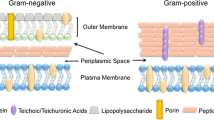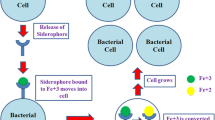Abstract
The wild-type strain and mutants ofEscherichia coli lacking Mn-superoxide dismutase (Sod A) or Fe-superoxide dismutase (Sod B) are compared for their sensitivity to the H2O2 insult (exposure for 15 min at 37°C, in M9 salts). Whereas mode one killing is similar in superoxide dismutase mutants and wild-type cells, the latter strain appears to be more resistant than the former ones to mode two lethality. Furthermore, Sod B cells, as well as wild-type cells but unlike Sod A cells, are capable of reversing the toxicity of the oxidant (even in the presence of chloramphenicol), this effect being observed by gradually increasing the H2O2 concentration from 2.5 to 10 mM. It is concluded that (a) superoxide ions may not be involved in the production of mode one killing by H2O2, although further experiments are needed to validate or modify this hypothesis; (b) superoxide ions mediate mode two killing by H2O2, possibly by reducing trivalent iron to the divalent form; and (c) the intervening zone of partial resistance observed in wild-type and Sod B cells exposed to intermediate H2O2 concentrations is not a consequence of Mn-superoxide dismutase induction; it would appear, however, that cells lacking this superoxide dismutase isoenzyme are not proficient in this acquired response.
Similar content being viewed by others
Literature Cited
Asada K, Yoshikawa K, Takahashi Y, Maeda Y, Enmanji K (1975) Superoxide dismutases from a blue-green algae,Plectonema boryanum. J Biol Chem 250:2801–2807
Brandi G, Sestili P, Pedrini MA, Salvaggio L, Cattabeni F, Cantoni O (1987) The effect of temperature or anoxia inEscherichia coli killing by hydrogen peroxide. Mutat Res 190:237–240
Brandi G, Cattabeni F, Albano A, Cantoni O (1988) Role of hydroxyl radicals inEscherichia coli killing by hydrogen peroxide. Submitted
Carlioz A, Touati D (1986) Isolation of superoxide dismutase mutants inEschericha coli: is superoxide dismutase necessary for life? EMBO J 5:623–630
Dougherty HV, Sadowski SJ, Baker EE (1978) A new iron-containing superoxide dismutase fromEscherichia coli. J Biol Chem 253:5220–5223
Harris JI, Auffret AD, Northrop FD, Walker JE (1980) Structural comparisons of superoxide dismutases. Eur J Biochem 106:297–303
Hassan HM, Fridovich I (1977) Enzymic defences against the toxicity of oxygen and of streptonigrin inEscherichia coli. J Bacteriol 129:1574–1583
Imlay JA, Linn S (1986) Bimodal pattern of killing of DNA-repair-defective or anoxically grownEscherichia coli by hydrogen peroxide. J Bacteriol 166:519–527
Sakamoto H, Touati D (1984) Cloning of the iron superoxide dismutase gene (SodB) inEscherichia coli K-12. J Bacteriol 159:418–420
Steinman HM (1978) The amino acid sequence of mangano superoxide dismutase fromEscherichia coli B. J Biol Chem 253:8708–8720
Touati D (1983) Cloning and mapping of the manganese superoxide dismutase gene (SodA) ofEscherichia coli K-12. J Bacteriol 155:1078–1085
Author information
Authors and Affiliations
Rights and permissions
About this article
Cite this article
Brandi, G., Schiavano, G.F., Magnani, M. et al. Superoxide anions are required for the inactivation ofEscherichia coli induced by high concentrations of hydrogen peroxide. Current Microbiology 17, 117–120 (1988). https://doi.org/10.1007/BF01568796
Issue Date:
DOI: https://doi.org/10.1007/BF01568796




